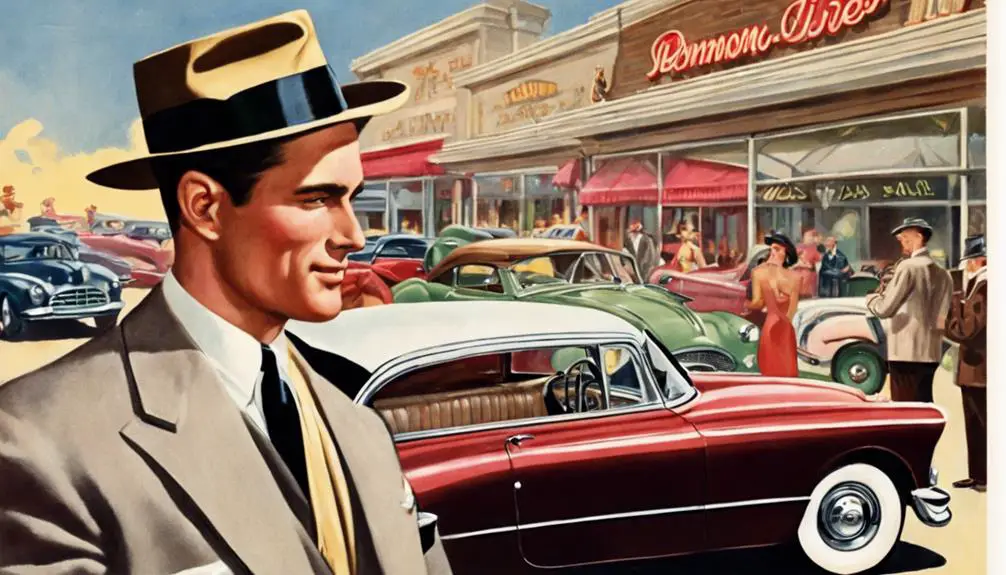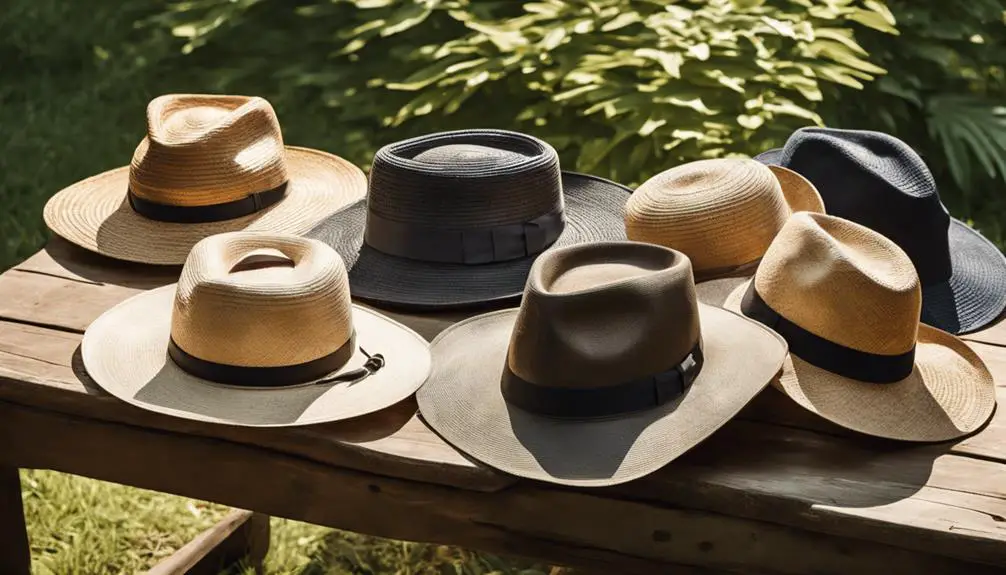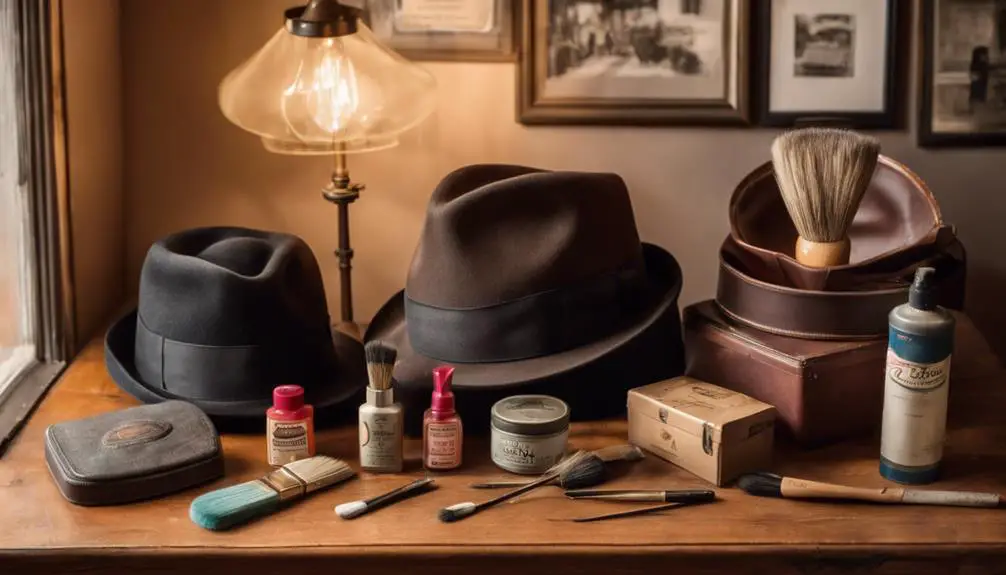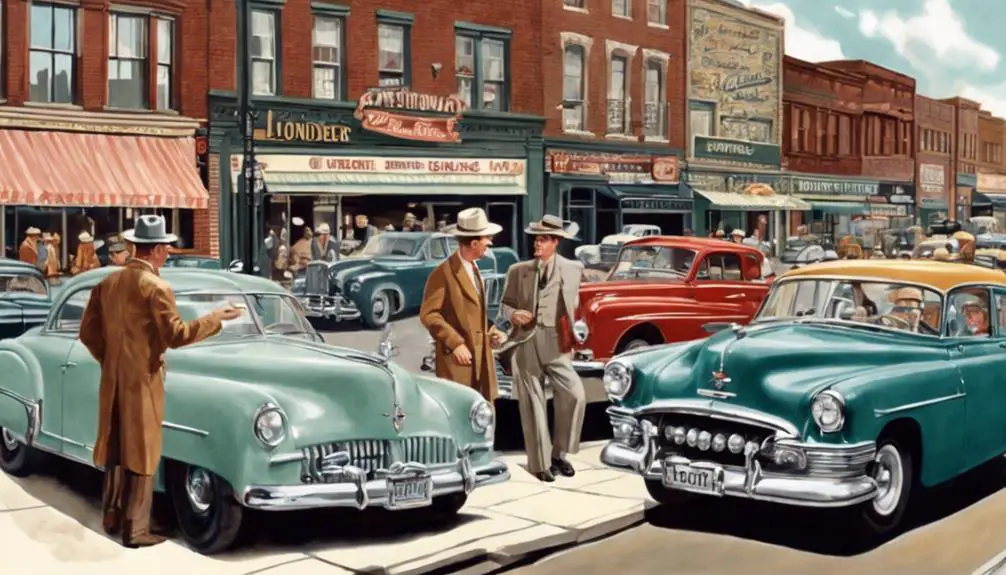In the 1950s, men's hats were essential fashion statements that conveyed personal style and social standing. The fedora, often associated with icons like Frank Sinatra, became a staple, while the trilby offered a sleeker profile. The pork pie hat emerged as a symbol of youthful rebellion, tied to jazz culture. Woven straw hats, such as Panamas, reflected the decade's vibrant spirit, perfect for outdoor gatherings. Colors and bands added a personal touch, as Hollywood and youth culture influenced trends. Understanding these influences helps you appreciate the significance of these hats in shaping men's fashion during this transformative era.
Overview of 1950s Hat Styles

In the vibrant landscape of 1950s fashion, men's hats played a pivotal role in defining personal style and social status. Among these, the fedora stood out as a quintessential choice, embodying sophistication and charm. Frank Sinatra's influence popularized the stingy brim fedora, characterized by its wide brim and creased crown, which became synonymous with elegance during this era.
As you explore vintage hats from this decade, you'll notice a variety of styles that catered to diverse tastes. The Tremont hat, a fusion of homburg and fedora, emerged as a versatile option, perfect for both formal and casual settings with its pinched crown and narrow snap brim. The pork pie hat also made a comeback, flaunting a taller crown and wide band, often tilted for a trendy flair.
Straw hats, including the Panama, adorned with bold, colorful bands, reflected the lively spirit of the 1950s. This decade's hat styles not only complemented outfits but also conveyed messages about the wearer's identity and social standing, making them essential accessories in shaping the era's fashion narrative.
Popular Fedora and Trilby Variants
Frequently, the Fedora and Trilby hats of the 1950s exemplified the era's evolving fashion sensibilities, making them essential pieces for the stylish man. The Fedora hat, with its wide brim and creased crown, was popularized by icons like Frank Sinatra and made from materials such as fur felt and woven straw. In contrast, the Trilby emerged as a fashionable variant, boasting a shorter brim and narrower profile, appealing to a contemporary audience.
As the decade progressed, both styles underwent a transformation. By the late 1950s, their dimensions shrank, reflecting changing tastes. The stingy brim Fedora, in particular, became a lasting symbol of sophistication, often associated with a casual yet polished look.
Here's a brief overview of the contrasting features of these iconic hats:
| Hat Type | Key Features |
|---|---|
| Fedora | Wide brim, creased crown, versatile colors |
| Trilby | Shorter brim, narrower profile |
Common colors included brown, tan, green, blue, grey, and black, allowing for seamless integration into various outfits. Ultimately, both the Fedora and Trilby captured the essence of 1950s style, each serving a unique role in men's fashion.
Unique Tremont Hat Design

As the 1950s progressed and fashion continued to evolve, the Tremont Hat emerged as a distinctive option that cleverly blended elements of both the homburg and fedora styles. This vintage style features a center dent crown and straight sides, striking a balance between sophistication and casual flair. The narrow snap brim enhances its versatility, making the Tremont Hat ideal for both formal events and informal gatherings.
What truly sets the Tremont Hat apart is its pinched crown design, which contributes to its unique silhouette while preserving a classic appeal. This combination of features allows you to make a statement, whether you're dressing up for a special occasion or simply enhancing your everyday attire. Crafted mainly from felt, the Tremont Hat comes in a range of colors, providing ample opportunity for personalization and expression.
The rise of the Tremont Hat in the 1950s reflects broader trends in men's fashion, where hats became essential accessories to complete a polished look. As you explore this unique design, you'll appreciate how it encapsulates the spirit of the era, merging stylish aesthetics with practical functionality.
Resurgence of Pork Pie Hats
With the rise of jazz music and the beatnik movement in the 1950s, the pork pie hat gained significant traction as a fashionable accessory. This hat, characterized by its taller crown and wide hat band, was often worn at an angle, giving off an effortlessly stylish vibe. As you explore this vintage mens' trend, you'll notice that common colors included dark brown and dark grey, with brims narrowing to around 2 inches.
The terrace top variant, featuring a creased inner ring, stood out as a distinctive choice for those keen on fashion. The pork pie hat became emblematic of youthful rebellion, reflecting a shift towards more casual yet stylish headwear.
Here's a quick look at its key features:
| Feature | Description |
|---|---|
| Crown Height | Taller crown |
| Brim Width | Approximately 2 inches |
| Common Colors | Dark brown, dark grey |
| Cultural Association | Jazz musicians, beatniks |
As cultural influences from music and film spilled into fashion, the pork pie hat solidified its place as a symbol of individuality and style during this vibrant decade.
Diverse Styles of Straw Hats

The 1950s saw an explosion of diverse straw hat styles that complemented the era's vibrant fashion landscape. Among the popular men's hat styles were boater, fedora, Panama, telescope, and pork pie, each distinguished by its unique shape and flair. With brims typically ranging from 2 to 3 inches, these hats offered a perfect balance of style and functionality, especially during the warm summer months when sun protection was paramount. Vintage clothing enthusiasts often recognize the significance of these hats as part of the broader fashion trends of the time, including their distinctive labels and craftsmanship vintage clothing identification.
Woven straw hats became a favorite for their lightweight and breathable qualities, making them suitable for both casual outings and semi-formal events. The hats featured bold, colorful hat bands crafted from luxurious silks and pleated puggarees, often adorned with geometric prints or novelty tropical designs, reflecting the era's cultural optimism and zest for life.
This resurgence of straw hats mirrored the growing trend of outdoor social activities, as men embraced the leisure culture of the time. By incorporating these diverse styles into their wardrobes, you could express individuality while enjoying the season's sunny festivities. Overall, straw hats in the 1950s were more than just accessories; they were a statement of style and a celebration of the carefree spirit of the decade.
Cultural Influences on Hat Trends
Cultural influences profoundly shaped men's hat trends in the 1950s, making these accessories not just fashionable but emblematic of the era's shifting social dynamics. Hollywood played a pivotal role, with icons like Frank Sinatra and Marlon Brando showcasing hats in films, prompting fans to adopt similar styles. This visibility in popular culture made hats a must-have for many men.
Additionally, the rise of youth culture, driven by rock 'n' roll and jazz, diversified mens hats, appealing to younger generations keen to express their individuality. Fashion magazines of the time solidified this trend, presenting hats as essential wardrobe staples, further embedding them into the fabric of daily life.
As social movements and changing gender roles emerged, traditional masculinity was reevaluated, influencing how men wore hats in both public and private settings. The decade's end marked a significant cultural shift, highlighted by JFK's hatless inauguration, which signaled a decline in hat-wearing. This change reflected broader changes in societal norms, emphasizing individuality over conformity. Consequently, the 1950s served as a vital period in the evolution of men's hats, blending fashion with cultural identity.
Care and Maintenance Tips

To keep your vintage hats looking their best, proper care and maintenance are imperative. First, storage plays a significant role. Always place your hats in a cool, dry place to avoid crushing and maintain their shape. For felt hats, regular brushing is key; this helps remove dust and dirt that can accumulate over time. Straw hats, on the other hand, require a gentler approach—just wipe them down with a damp cloth to prevent damage.
It's essential to conduct regular inspections of your vintage caps, looking for signs of wear like fraying or discoloration. Early detection allows you to address issues before they worsen. To help retain the shape of your hats, avoid exposing them to moisture and invest in quality hat boxes or storage containers.
If you find your vintage hats heavily worn, don't despair. Restoration options are available, including professional cleaning and reshaping services that can bring them back to life. By following these care and maintenance tips, you can guarantee your vintage hats remain stylish and endure the test of time.
Modern Revival of Vintage Styles
Reviving 1950s hat styles has become a notable trend in contemporary fashion, driven by a blend of nostalgia and modern aesthetics. You'll notice that vintage markets and online retailers are buzzing with demand for classic designs like the Straw Fedora and newsboy caps. As vintage enthusiasts seek to understand the importance of tag identification, social media platforms amplify this trend, showcasing how these vintage hats can elevate your everyday outfits, making them appealing to younger generations keen for unique fashion statements.
Events like themed parties and retro festivals provide perfect venues for enthusiasts to flaunt their vintage finds, reinforcing the charm of these timeless accessories. As you explore this revival, you'll find a growing appreciation for craftsmanship and the rich history behind each piece, particularly with materials like Harris tweed, which adds a sophisticated touch to any look.
The ease of finding rare vintage hats online has solidified these styles in today's fashion landscape, enabling collectors like you to curate an authentic collection. This vibrant market reflects not just a trend, but a movement towards embracing vintage aesthetics and the stories they carry. In this way, 1950s hat styles are not just being worn—they're being celebrated.
Regional Variations in Hat Preferences

Regional variations in hat preferences during the 1950s reveal a fascinating tapestry of local identities and cultural influences. In states like New Jersey, many men and boys opted to shun hats altogether, reflecting a regional trend that contrasted sharply with other areas where hats were integral to daily life. In rural regions, particularly Cumbria, flat caps emerged as the preferred choice, celebrated for their practicality in agricultural work.
Across the United States, the choice of hat styles varied considerably, shaped by local cultures and industries. Warmer climates favored lightweight straw hats, such as Panamas and fedoras, allowing for breathability and comfort. Conversely, cooler regions leaned towards fur felt hats, which provided essential insulation against the elements.
In several areas, wearing a hat became synonymous with professionalism and respectability, guiding men to adopt specific styles that aligned with local occupational norms. This nuanced landscape of hat preferences illustrates how regional identities influenced not just fashion but also social interactions and perceptions of status during the 1950s. Understanding these variations offers deeper insights into the era's cultural fabric.
Buying Vintage 1950s Hats
Maneuvering the world of vintage 1950s hats can be an exciting yet nuanced experience for collectors and fashion enthusiasts alike. When you set out to buy these vintage hats, you'll quickly discover that prices can swing dramatically. For instance, fedoras might range from $15 to over $500, influenced heavily by brand and condition. If you're eyeing an authentic Stetson Royal Deluxe Open Road, expect to pay around $330. Unique finds, such as the sought-after Dobbs Fedora, can fetch even higher bids.
As you browse, always check the condition meticulously. Listings often label hats as "great condition" or "as is," and features like fur felt or beaver blend may greatly impact value. Don't overlook sizing details, either; vintage hats often specify sizes, like the 1950s Stetson Imperial Fedora in size 7 1/8 for $308.
The growing interest in vintage fashion means you'll encounter active bidding and competitive prices. Many listings even offer "or best offer" options, allowing for negotiation. Remember, whether you're looking for a classic fedora or a unique Baseball Cap, careful research will enhance your buying experience.
Frequently Asked Questions
What Hats Did Men Wear in the 1950s?
In the 1950s, you'd find men wearing a variety of hats like fedoras, trilbies, and pork pies, each reflecting personal style and cultural influences, while cowboy and newsboy caps added practicality to their wardrobes.
What Hats Did Men Wear in 1940?
In 1940, you'd see men donning fedoras, pork pie hats, and newsboy caps. Each style reflected social status and personal flair, with fedoras symbolizing sophistication and newsboy caps showcasing everyday charm in urban settings.
Did Men Wear Hats in the 1960s?
In the 1960s, you'd notice a marked decline in men's hat-wearing. Cultural shifts and changing fashion norms led many to forgo hats, especially after JFK's iconic hatless inauguration, signaling a new style era.
When Did American Men Stop Wearing Hats?
You'll notice American men largely stopped wearing hats in the early 1960s, especially after Kennedy's inauguration. Cultural shifts and changing fashion norms made hats feel outdated, leading to their decline as everyday accessories.



